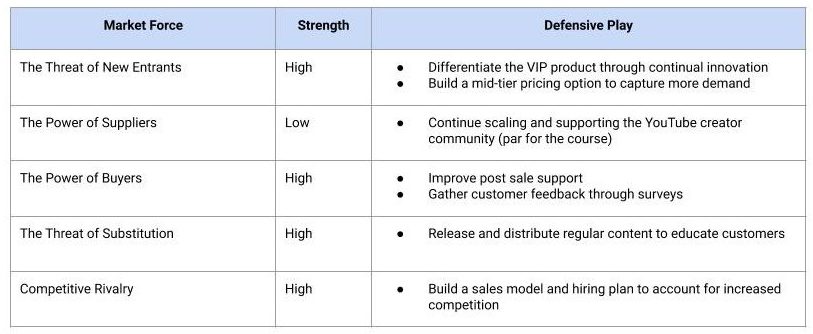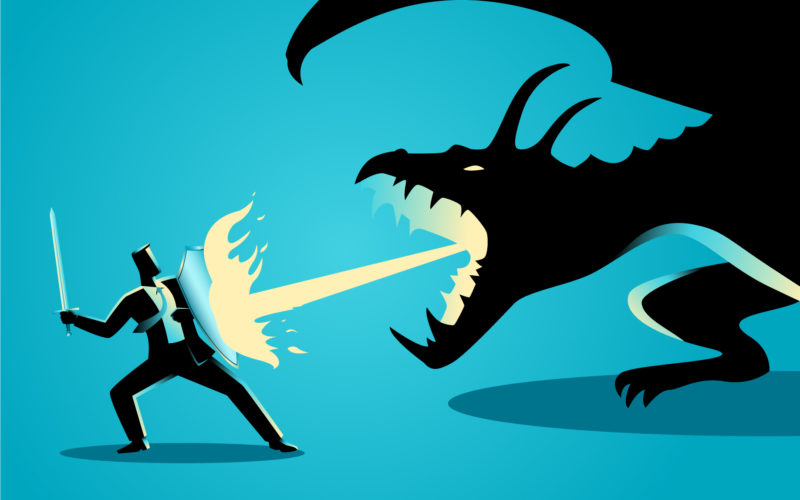If one doesn’t understand the five forces in their industry and prepare to protect their company against them, they will become another casualty in the startup graveyard. Many founders believe that the goal is to get traction in the market. To find the legendary “product-market fit.” That is step one, but the real test is to maintain that traction for several years, as the forces of the market attack your company from all sides. Looking back at my journey, although FameBit survived and made it to a successful exit, it was a bit like playing a video game on the hard setting. It didn’t need to be so difficult. it would have been more enjoyable, less stressful, and had nearly the same satisfaction to lower the difficulty.
If I was able to travel back in time to 2015, here are some things I would have done differently to combat the five forces in the YouTube influence marketing industry:
Item One: Work to Improve FameBit’s product differentiation from day one
The Situation: the value proposition of FameBit’s VIP service was not defensible and easily copied by competitors. We employed a value strategy: advertisers obtained lots of YouTube branded content for a low price. Later we began guaranteeing organic views, mainly because customers pushed us into it (because they had the power to do so), which is also easy to copy. This meant that firms were entering the market (due to low barriers to entry), and pitching the same product: content at scale, low price, guaranteed organic views.
Solution: From day one we should have worked tirelessly to differentiate our VIP product through innovation, making it more difficult to copy. For example, we provided customers with tracking links through our self-service platform, and a dashboard to aggregate the data. Could we have used this data to optimize customers campaigns for VIP? Could we have leveraged the platform to gather additional data (through surveys, or another mechanism) from the YouTubers to enhance matchmaking? We did leverage our platform to help generate lists of interested YouTubers for VIP brand campaigns, which was a competitive advantage, but it was not enough. We had an amazing platform and we did not leverage it sufficiently to build a defensible competitive advantage.
Item Two: Create a mid-tier pricing option to capture lost demand
The Situation: Our customers had two options: pay as you go self-service, which allowed brands to purchase content as low as $50, or our VIP managed service, which was $10,000 minimum per campaign. At $10,000 a pop, we sold too many VIP campaigns, and we couldn’t hire additional team members to fulfill the campaigns fast enough. So we began to raise the minimum fee to reduce demand and increase the VIP revenue per brand. Within six months the minimum was $25,000, and then we tried to raise it to $50,000. Around this time, demand began to fall: we had not hired enough salespeople to maintain growth as competition increased.
Solution: We could have tried to capture the lost demand by building a “middle ground” mid-tier option for customers that wanted to spend $10K or $15K, but couldn’t step up to $50K. Customers that wanted a managed service at a lower threshold were being pushed to the competition. If we had a lower touch option, for example pre-packaged bundles of creators by vertical that you could purchase through the platform, or a reduced white-glove service for lower tier spends, it would have helped to capture this demand.
Item Three: Improve our post sales support & gather feedback from customers
The Situation: We were so focused on acquiring new customers that we did not focus well enough on post-sales support. For example, setting up wrap up calls to review campaign performance and gathering customer feedback. We also did not survey our customers using a formalized method. In our industry the competition was high and the switching cost was low, which meant buyers had a great deal of power. Not focusing enough on customer satisfaction resulted in high churn rates.
Solution: We should have set up a standardized client success process from day one that included review calls at the end of campaigns, high-quality reports, and a post-campaign survey. A simple survey would have provided invaluable data that we could have used to improve our processes and product offering. By “going the extra mile” for our customers, we would have been able to reduce churn rates.
Item Four: Release and distribute regular content to educate the market
The Situation: we produced no content focused on promoting or educating brands on our VIP service, and very limited content to educate brands on the industry. Looking back, this was a huge mistake. For example, many buyers were confused by our CPV (cost-per-view) model. Ours CPVs were typically in the $0.06 to $0.08 range, equivalent to a CPM of $60 to $80. When you compare a YouTube CPV to a typical ad CPM, it looks expensive. What buyers didn’t realize is that a YouTube video view and an ad impression are not equivalent. A viewer watching content for 5 minutes because they respect the creator’s opinion, or love watching their content, is not the same as a random ad impression popping up in the corner of your screen.
Solution: We should have produced and distributed a higher volume of educational content. This would have helped to position us as the leader in the market, and empowered buyers to ask the right questions to competitors. This content would have also helped to generate leads by resolving customer objections preemptively and reduced the threat of substitution by emphasizing the unique value of YouTube influence marketing.
Item Five: Build a sales model to prepare for increased competition and reduced sales per head
Situation: In the early days of the market, it was easy for a single salesperson to “kill it.” As more firms began to enter the market due to low barriers to entry (those pesky new entrants again!), the increased competition meant that individual salespeople had a harder time closing deals. As time passed, we needed more sellers to close the same amount of new revenue. We were confused when sales per seller began to drop, and did not realize that this was a normal development in a highly competitive market. Instead of doubling down on hiring we pulled back in fear.
Solution: Factor increased competition into the companies long-term sales model. Build a hiring plan to hire fast enough to mitigate the drop in revenue per head as the market evolves. It is impossible to know this exactly, but if you factor it into your model you’ll at least have an estimate.
Let’s look at a summary of the defensive moves:

Note: this list is not exhaustive, and some of the defensive plays can be matched to multiple forces.
I recommend that anyone in a leadership position at a startup run through a similar exercise with their own company. By striving to understand the dynamics of your industry you’ll be able to peer in a crystal ball and “see the future.” Don’t be in denial about your industry. Take a hard look at reality and build a mote to protect your startup against the five forces. Build a startup that successfully finds product-market fit AND survives as the market evolves for many years into the future. Good luck out there!
